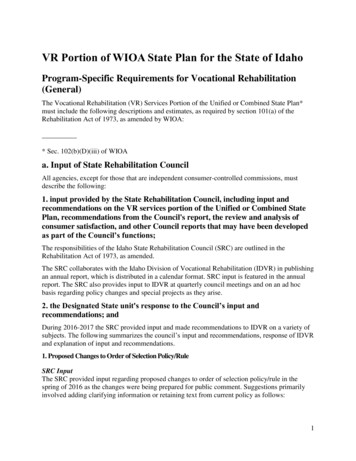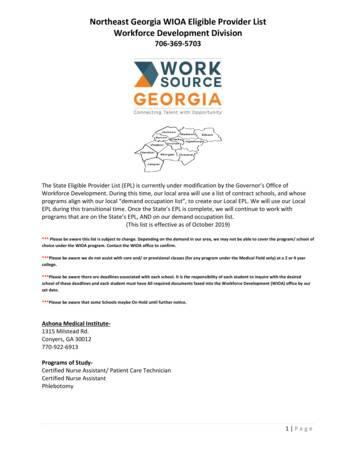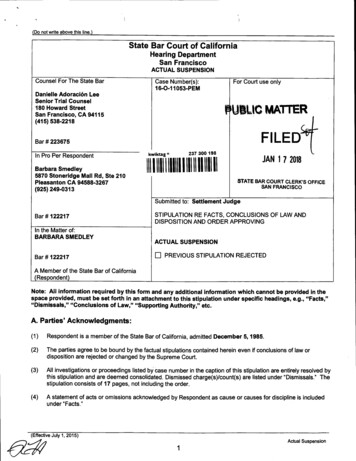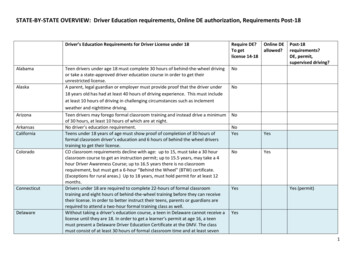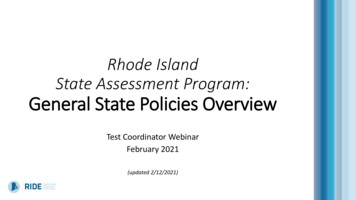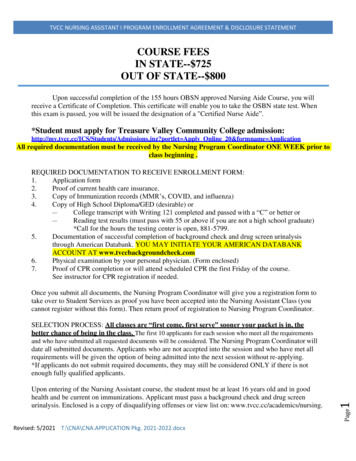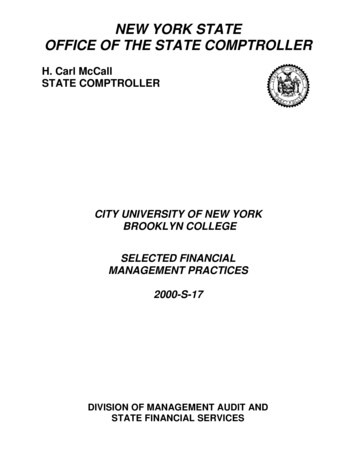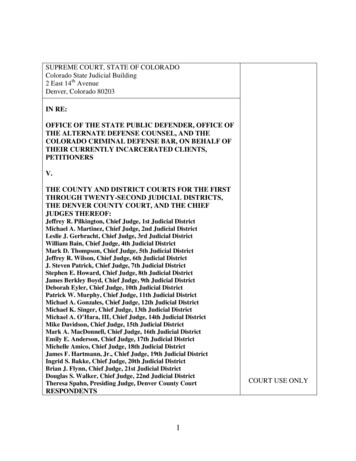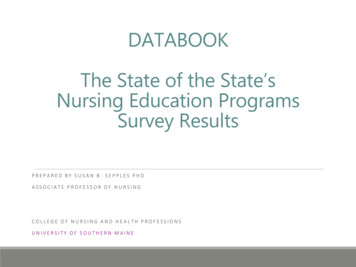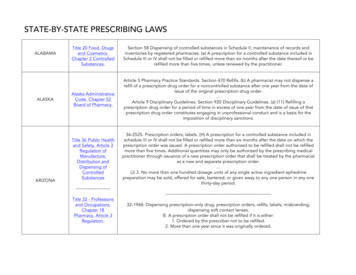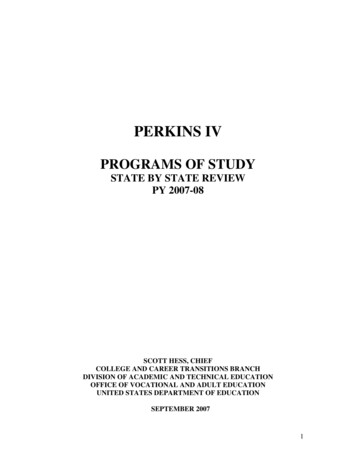
Transcription
WIOA STATE PLAN FOR THE STATE OF IDAHO FY-2018
CONTENTSWIOA State Plan for the State of Idaho FY-2018 . 1Overview . 4Options for Submitting a State Plan . 4How State Plan Requirements Are Organized . 5I. WIOA State Plan Type . 7Combined Plan partner program(s). 7II. Strategic Elements . 8a. Economic, Workforce, and Workforce Development Activities Analysis . 8b. State Strategic Vision and Goals . 53c. State Strategy. 58III. Operational Planning Elements . 66A. State Strategy Implementation . 66b. State Operating Systems and Policies . 95IV. Coordination with State Plan Programs . 138Section IV - Coordination with Combined Plan Programs . 138V. Common Assurances (for all core programs) . 141VI. Program-Specific Requirements for Core Programs . 143Program-Specific Requirements for Adult, Dislocated Worker, and Youth Activities under TitleI-B . 143Program-Specific Requirements for Wagner-Peyser Program (Employment Services) . 187Program-Specific Requirements for Adult Education and Family Literacy Act Programs. 209Program-Specific Requirements for Vocational Rehabilitation (General). 226Program-Specific Requirements for Vocational Rehabilitation (Blind). 291VII. Program-Specific Requirements For Combined State Plan Partner Programs . 331Trade Adjustment Assistance (TAA). 331Jobs for Veterans’ State Grants . 334Senior Community Service Employment Program (SCSEP) . 346Appendix 1. Performance Goals for the Core Programs . 364Table 1. Employment (Second Quarter after Exit) . 365Table 2. Employment (Fourth Quarter after Exit) . 366Table 3. Median Earnings (Second Quarter after Exit). 367Table 4. Credential Attainment Rate . 367Table 5. Measureable Skill Gains . 368Page 2
Table 6. Effectiveness in Serving Employers . 369Table 7. Additional Indicators of Performance. 370Appendix 2. Other State Attachments (Optional). 371Page 3
OVERVIEWUnder the Workforce Innovation and Opportunity Act (WIOA), the Governor of each State mustsubmit a Unified or Combined State Plan to the Secretary of the U.S. Department of Labor thatoutlines a four-year strategy for the State’s workforce development system. The publicly-fundedworkforce development system is a national network of Federal, State, regional, and local agenciesand organizations that provide a range of employment, education, training, and related services andsupports to help all job-seekers secure good jobs while providing businesses with the skilledworkers they need to compete in the global economy. States must have approved Unified orCombined State Plans in place to receive funding for core programs. WIOA reforms planningrequirements, previously governed by the Workforce Investment Act of 1998 (WIA), to fosterbetter alignment of Federal investments in job training, to integrate service delivery acrossprograms and improve efficiency in service delivery, and to ensure that the workforce system isjob-driven and matches employers with skilled individuals. One of WIOA’s principal areas ofreform is to require States to plan across core programs and include this planning process in theUnified or Combined State Plans. This reform promotes a shared understanding of the workforceneeds within each State and fosters development of more comprehensive and integratedapproaches, such as career pathways and sector strategies, for addressing the needs of businessesand workers. Successful implementation of many of these approaches called for within WIOArequires robust relationships across programs. WIOA requires States and local areas to enhancecoordination and partnerships with local entities and supportive service agencies for strengthenedservice delivery, including through Unified or Combined State Plans.OPTIONS FOR SUBMITTING A STATE PLANA State has two options for submitting a State Plan — a Unified State Plan or a Combined State Plan.At a minimum, a State must submit a Unified State Plan that meets the requirements described inthis document and outlines a four-year strategy for the core programs. The six core programs are— the Adult program (Title I of WIOA),the Dislocated Worker program (Title I),the Youth program (Title I),the Adult Education and Family Literacy Act program (Title II),the Wagner-Peyser Act program (Wagner-Peyser Act, as amended by title III), andthe Vocational Rehabilitation program (Title I of the Rehabilitation Act of 1973, as amendedby Title IV).Alternatively, a State may submit a Combined State Plan that meets the requirements described inthis document and outlines a four-year strategy for WIOA’s core programs plus one or more of theCombined Plan partner programs. When a State includes a Combined State Plan partner program inits Combined State Plan, it need not submit a separate plan or application for that particularprogram. If included, Combined State Plan partner programs are subject to the “common planningelements” (Sections II and III of this document) where specified, as well as the program-specificrequirements for that program where such planning requirements exist separately for the program.The Combined State Plan partner programs are—Page 4
Career and technical education programs authorized under the Carl D. Perkins Career andTechnical Education Act of 2006 (20 U.S.C. 2301 et seq.)Temporary Assistance for Needy Families Program (42 U.S.C. 601 et seq.)Employment and Training Programs under the Supplemental Nutrition Assistance Program(Programs authorized under section 6(d)(4) of the Food and Nutrition Act of 2008 (7 U.S.C.2015(d)(4)))Work programs authorized under section 6(o) of the Food and Nutrition Act of 2008 (7U.S.C. 2015(o))Trade Adjustment Assistance for Workers Programs (Activities authorized under chapter 2of Title II of the Trade Act of 1974 (19 U.S.C. 2271 et seq.))Jobs for Veterans State Grants Program (Programs authorized under 38, U.S.C. 4100 et. seq.)Unemployment Insurance Programs (Programs authorized under State unemploymentcompensation laws in accordance with applicable Federal law)Senior Community Service Employment Program (Programs authorized under Title V of theOlder Americans Act of 1965 (42 U.S.C. 3056 et seq.))Employment and training activities carried out by the Department of Housing and UrbanDevelopmentCommunity Services Block Grant Program (Employment and training activities carried outunder the Community Services Block Grant Act (42 U.S.C. 9901 et seq.))*Reintegration of Ex-Offenders Program (Programs authorized under section 212 of theSecond Chance Act of 2007 (42 U.S.C. 17532))* States that elect to include employment and training activities carried out under the CommunityServices Block Grant (CSBG) Act (42 U.S.C. 9901 et seq.) under a Combined State Plan would submitall other required elements of a complete CSBG State Plan directly to the Federal agency thatadministers the program. Similarly, States that elect to include employment and training activitiescarried by the Department of Housing and Urban Development and programs authorized undersection 6(d)(4) and 6(o) of the Food and Nutrition Act of 2008 that are included would submit allother required elements of a complete State Plan for those programs directly to the Federal agencythat administers the program.HOW STATE PLAN REQUIREMENTS ARE ORGANIZEDThe major content areas of the Unified or Combined State Plan include strategic and operationalplanning elements. WIOA separates the strategic and operational elements to facilitate crossprogram strategic planning. The Strategic Planning Elements section includes analyses of the State’s economicconditions, workforce characteristics, and workforce development activities. These analysesdrive the required vision and goals for the State’s workforce development system andalignment strategies for workforce development programs to support economic growth.The Operational Planning Elements section identifies the State’s efforts to support theState’s strategic vision and goals as identified in the Strategic Planning Elements section.This section ensures that the State has the necessary infrastructure, policies, and activitiesto meet its strategic goals, implement its alignment strategy, and support ongoing programdevelopment and coordination. Operational planning elements include:Page 5
oooooState Strategy Implementation,State Operating Systems and Policies,Assurances, andProgram-Specific Requirements for the Core Programs, andProgram-Specific Requirements for the Combined State Plan partner programs.(These requirements are available in a separate supplemental document,Supplement to the Workforce and Innovation Act (WIOA) Unified and CombinedState Plan Requirements. The Departments are not seeking comments on theseparticular requirements).When responding to Unified or Combined State Plan requirements, States must identify specificstrategies for coordinating programs and services for target populations.* States must developstrategies that look beyond strategies for the general population and develop approaches that alsoaddress the needs of target populations.* Target populations include individuals with barriers to employment, as defined in WIOA Sec. 3, aswell as veterans, unemployed workers, and youth.Page 6
I. WIOA STATE PLAN TYPEUnified or Combined State Plan. Select whether the State is submitting a Unified or CombinedState Plan. At a minimum, a State must submit a Unified State Plan that covers the six coreprograms.Unified State Plan. This plan includes the Adult Program, Dislocated Worker Program, YouthProgram, Wagner-Peyser Act Program, Adult Education and Family Literacy Act Program, andVocational Rehabilitation Program. NoCombined State Plan. This plan includes the Adult, Dislocated Worker, Youth, Wagner-Peyser Act,Adult Education and Family Literacy Act, and Vocational Rehabilitation programs, as well as one ormore of the optional Combined State Plan partner programs identified below. YesCOMBINED PLAN PARTNER PROGRAM(S)Indicate which Combined State Plan partner program(s) the State is electing to include in the plan.Career and technical education programs authorized under the Carl D. Perkins Career andTechnical Education Act of 2006 (20 U.S.C. 2301 et seq.) NoTemporary Assistance for Needy Families Program (42 U.S.C. 601 et seq.)NoEmployment and Training Programs under the Supplemental Nutrition Assistance Program(Programs authorized under section 6(d)(4) of the Food and Nutrition Act of 2008 (7 U.S.C.2015(d)(4))) NoWork programs authorized under section 6(o) of the Food and Nutrition Act of 2008 (7 U.S.C.2015(o))) NoTrade Adjustment Assistance for Workers Programs (Activities authorized under chapter 2 of titleII of the Trade Act of 1974 (19 U.S.C. 2271 et seq.)) YesJobs for Veterans State Grants Program (programs authorized under 38, U.S.C. 4100 et. seq.)YesUnemployment Insurance Programs (Programs authorized under State unemploymentcompensation laws in accordance with applicable Federal law) NoSenior Community Service Employment Program (Programs authorized under title V of the OlderAmericans Act of 1965 (42 U.S.C. 3056 et seq.)) YesEmployment and training activities carried out by the Department of Housing and UrbanDevelopment NoCommunity Services Block Grant Program (Employment and training activities carried out underthe Community Services Block Grant Act (42 U.S.C. 9901 et seq.)) NoReintegration of Ex-Offenders Program (Programs authorized under section 212 of the SecondChance Act of 2007 (42 U.S.C. 17532))] NoPage 7
II. STRATEGIC ELEMENTSThe Unified or Combined State Plan must include a Strategic Planning Elements section thatanalyzes the State’s current economic environment and identifies the State’s overall vision for itsworkforce development system. The required elements in this section allow the State to developdata-driven goals for preparing an educated and skilled workforce and to identify successfulstrategies for aligning workforce development programs to support economic growth. Unlessotherwise noted, all Strategic Planning Elements apply to Combined State Plan partner programsincluded in the plan as well as to core programs.A. ECONOMIC, WORKFORCE, AND WORKFORCE DEVELOPMENT ACTIVITIES ANALYSISThe Unified or Combined State Plan must include an analysis of the economic conditions, economicdevelopment strategies, and labor market in which the State’s workforce system and programs willoperate.1. ECONOMIC AND WORKFORCE ANALYSISA. ECONOMIC ANALYSISThe Unified or Combined State Plan must include an analysis of the economic conditions and trendsin the State, including sub-State regions and any specific economic areas identified by the State.This must includeI. EXISTING DEMAND INDUSTRY SECTORS AND OCCUPATIONSProvide an analysis of the industries and occupations for which there is existing demand.II. EMERGING DEMAND INDUSTRY SECTORS AND OCCUPATIONProvide an analysis of the industries and occupations for which demand is emerging.III. EMPLOYERS’ EMPLOYMENT NEEDSWith regard to the industry sectors and occupations identified in 1 and 2 above, provide anassessment of the employment needs of employers, including a description of the knowledge, skills,and abilities required, including credentials and licenses.(I) EXISTING DEMAND INDUSTRY SECTORS AND OCCUPATIONSProvide an analysis of the industries and occupations for which there is existing demand.This section analyzes Idaho’s high-demand industries and provides an overview of Idaho’s TargetSectors. It also covers Idaho’s high-demand occupations, including an analysis of Idaho’s “Hot Jobs”list.HIGH-DEMAND INDUSTRIESThe Idaho Department of Labor reports that preliminary data for 2017 shows Idaho had 713,700nonfarm payroll jobs. As per Table 1 on the following page (and Data Appendix Table 1 - NonfarmJobs), the five highest-demand industries accounted for 55 percent of nonfarm jobs in Idaho in2017. These top five industries are health care and social services, retail trade, local government,Page 8
manufacturing, and accommodation and food service. The number of jobs in these five sectorsrange from 92,400 to 63,000.Since 2010, these five industries have grown steadily. The number of nonfarm jobs has increased110,100 during this period. The five major industries accounted for 56 percent of the growth. Thelargest was in health care and social services, 17,800, and the smallest in local government, 5,100.Table 1: Top 5 Major Industrial Sectors in Idaho, 2010-2017Major h Care AndSocial 89,100Retail 0Local GovernmentManufacturingAccommodationAnd Food ServicesID Total NonfarmPayroll DAHO TARGET 92,40081,50063,600713,700In 2010 Idaho Department of Labor staff began discussing potential target industries for the state. Thegroup analyzed the number of current jobs by industry, employment projections, wages paid and themultiplier impact of industries on Idaho’s economy. Staffing patterns of the potential industries wereanalyzed by high demand, growth and wages. Based on the analysis, five sectors were identified:advanced manufacturing, aerospace, high-tech, health care and power and energy.The Research and Analysis Bureau presents economic findings on a quarterly basis regarding Idaho’starget industry clusters to the Workforce Development Council. These findings and data are discussedat the Council level in order to monitor the continued relevance of these clusters in real time andmeasure their impact on Idaho’s economy and workforce.Since 2010, the research staff has produced business scans for each of these sectors. These sectorscontinue to provide a large number of jobs, are projected to grow in the next 10 years, and pay thehighest wages. The only change to the target sectors in the current plan is to group aerospace withadvanced manufacturing. Within advanced manufacturing, the state will focus on two specificindustries - aerospace and food production.In total, these target sectors provide about 30 percent of Idaho jobs. The largest is heath care at 11.7percent and the smallest is aerospace at 0.3 percent. Every sector has added jobs since 2010. Thelargest numeric growth was health care with over 14,800 new jobs and the smallest was power andenergy with 409 jobs. However, aerospace had the largest relative increase at 27 percent and highPage 9
tech the smallest with 2 percent. The high te
Apr 01, 2000 · the Vocational Rehabilitation program (Title I of the Rehabilitation Act of 1973, as amended by Title IV). Alternatively, a State may submit a Combined State Plan that meets the requirements described in this document and outlines a four -year strategy for WIOA’s core program
